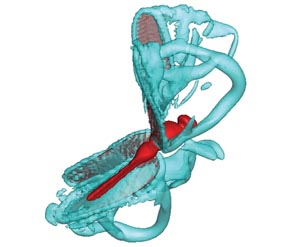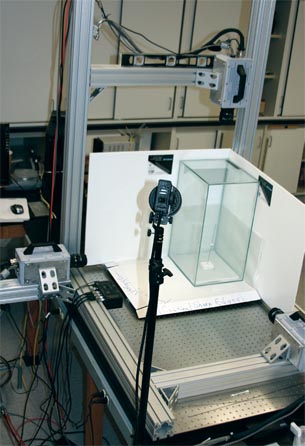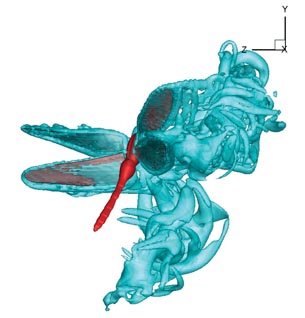Latest News
April 1, 2010
By Mike Peery
Researchers use CFD analysis and Tecplot visualization to map the flight of dragonflies for development of micro air vehicles.
In an increasingly disorienting and unsettling world—one filled with acts of terrorism, military conflicts across intractable geographies, and devastating natural disasters—the need to gather reliable information in difficult situations is more critical than ever. Whether it is in helping to prevent such an event or respond to one, having immediate access to accurate situational information can save lives, minimize injuries, and prevent the destruction of buildings, property, and infrastructure.
 Tecplot enabled researchers to analyze a dragonfly’s wing motion at different stages of flight to enable the development of a quad-winged micro air vehicle (MAV). |
It’s a big problem. But research currently being conducted at Wright State University in Dayton, Ohio, is focused on one solution no bigger than a bug. No bigger than a dragonfly, to be exact. Led by Haibo Dong, Ph.D., assistant professor at Wright State, the researchers’ goal is to develop quad-winged micro air vehicles (MAVs) that mimic the flight of the dragonfly. Among the purposes of such vehicles would be surveillance, environmental monitoring, search and rescue missions, and more in spaces too small or too dangerous for humans.
“Any time you can use robotics instead of people to gather information in areas that may be unstable, toxic, or hard to reach, you minimize the risk to public safety workers,” said Dong. “And any time you can use robotics in spaces that are too dangerous or too small for people to enter, you create an opportunity to prevent a catastrophe that might otherwise have occurred, or you create a chance for rescue where there might otherwise have been no hope.”
Building a Tiny, Agile Vehicle
The engineering challenge is to build a vehicle tiny and agile enough to maneuver in inaccessible spaces but that has enough power and lift to carry the payload it needs to gather information. It must negotiate hazards like fire, smoke, temperature extremes and toxic chemicals, as well as communicate with public safety officials. Nature perfected such a “device” millions of years ago in the form of the dragonfly.
Scientists have long known that this quad-winged creature is fast, agile, and requires significantly less energy than birds to lift and maneuver its relatively large body. But the complexities of the insect’s body motion, wing deformation and interaction, and the subsequent flow physics have been too difficult to unravel—until now.
 This photolab developed by researchers at Wright State University in Dayton, Ohio, was used to photograph and study the various stages of dragonfly flight. |
Using state-of-the-art image processing and computation tools, Dong and his team have recently become the first to create full-body 3D simulations of a four-winged insect in free flight. This latest development finally makes it possible for them to get the detailed information they need to build an MAV that truly mimics a dragonfly.
“Until recently, scientists have been able to look at individual insect parts,” said Dr. Dong. “We could look at a modeled wing in motion, for example, but we could not consider wing deformation and multi-wing interactions simultaneously. That may have been fine with two-winged insects, but the flow physics become so much more complex with four wings that we really must study the entire insect in free flight. We need to see how the wings and body deform or flex in relation to each other as it moves through the air. We need to look at the vortices, how they form, how they pass over the wings. We need to see how they respond to different conditions in nature. And all of it must be extremely precise.”
CFD Viz Pulls it Together
Dong has dedicated his career to the study of the flow physics that underlie the flight of hummingbirds and insects like bees, fruit flies, and dragonflies. He launched Wright State University’s Flow Simulation Research Group in the Department of Mechanical and Materials Engineering in 2006. Working on several multi-year grants, one of the group’s long-term goals is to develop quad-winged MAVs that can be used to monitor public areas, detect biological or chemical weapons, or help with search and rescue efforts.
It has been a slow, painstaking process for the team because of the large amount of data involved and the need for precision. The first step was to construct an efficient simulation model and then validate it against hundreds of scientific publications, studies, and observations on insect motion. Next, the team used three high-speed cameras at various critical angles to film dragonflies lifting off, and then imported those video images into SolidWorks 3D modeling software to reconstruct the insects’ surface shape. Once that was finished, the data was created in an in-house incompressible flow immersed-boundary Cartesian grids solver that simulates fluid flow around the dragonfly. High-performance computing in the form of beowulf clusters consisting of 20 compute nodes (each with a 2.8 GHz dual core Pentium 4 processor, 6 GB RAM, and 250 GB hard drive) were used in the number crunching.
Tecplot Illustrates the Science
Finally, the team’s work was ready to come to life using the Tecplot 360 CFD visualization software tool for visualization and data analysis. Pulling the 3D model and the solver data into Tecplot 360, they were able to replay simulations with enough precision, detail, and accuracy to recreate every motion a dragonfly makes on a lab computer.
Leveraging Tecplot’s CFD visualization technology will play a key role in helping Dong’s team develop these future aircraft. Because of the complexities of the four-winged insect’s body motion and wing deformation and interaction, the subsequent flow physics have been too difficult to unravel without being able to look at it with the human eye.
 This slice from an AVI visualized with Tecplot shows the unique movements of the four-winged insect. View a movie of the intricate wing movements and flow of air around them at deskeng.com. |
The team’s CFD solver generated all the numbers needed, but the researchers needed Tecplot 360 to find and understand the information hidden in their data. For example, the researchers might want to extract key features in the flow field, such as a streamlines, vortices, integrating pressure, and shear stress to calculate lift and drag. Tecplot 360 takes care of that for them.
While the 3D animations grab the most attention and fire the imagination, the researchers also rely heavily on the 2D images, plots, and charts created with Tecplot 360 to analyze data and communicate results. Still images help them examine the action frame by frame and x,y plotting enables the team to look at force history to learn how the wing is generating force or where the air is moving. 2D cross-sections can offer more detail on wing tips, for example, that show how they influence force production.
Cool Animations, But Data Key
“The 3D animations are probably the coolest part. We can rotate the body, look at the structure, examine vortices, and gain a deep understanding of the physics,” said Dong. “But this is physics-based analysis, and that always involves lots of plots and graphs. To us, the information we glean from the 2D results is just as exciting.”
This knowledge will also lead to a greater understanding of how dragonflies control their four separate wings. The wings, each controlled by five muscles, deform in shape and move in complicated patterns. It’s important for researchers to understand exactly how the individual muscles interact with the wings to create the correct flow physics. That requires a great deal of data and a lot of visualization.
Dong, who has supervised several senior design teams in developing “flying robots” that included different actuators (e.g., motors and piezoelectric actuators) and different sizes (from 2.5 in. to 7 in.), suggests that the current design of the dragonfly MAV has two critical design steps that still need to be completed. They are currently working on a design 1.5 times larger than a dragonfly with a current model that has about a 6 in. wing span and is 3 in. long.
“Once that works,” said Dong, “we will build a four-inch model. And then things will start to get very exciting.”
Other project contributors include Dr. Hui Wan, Zongxian Liang, Zach Gaston, and Matt Maples from the WSU Mechanical Engineering Department; Dr. Thomas Wischgoll and Chris Koehler in the WSU Computer Sciences Department; and Dr. Yan Zhuang from the WSU Electrical Engineering Department.
More Info:
Mike Peery is co-founder, president, and CEO of Tecplot. He has more than 30 years of experience in the development of software products for CFD analysis and scientific/engineering visual data analysis. Send comments to DE-Editorsmailto:[email protected].
Subscribe to our FREE magazine, FREE email newsletters or both!
Latest News






